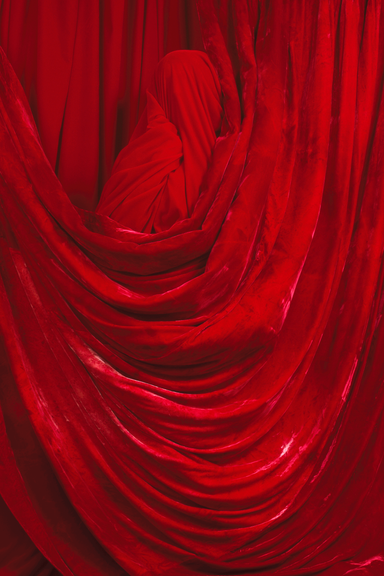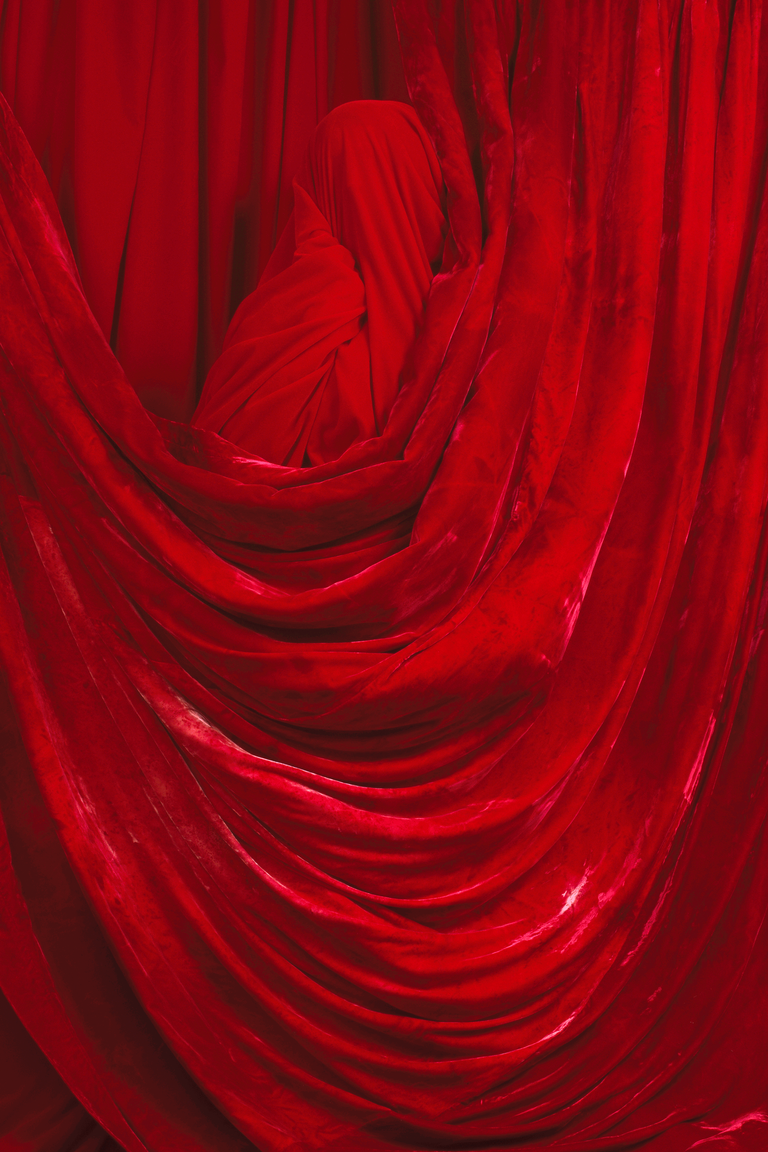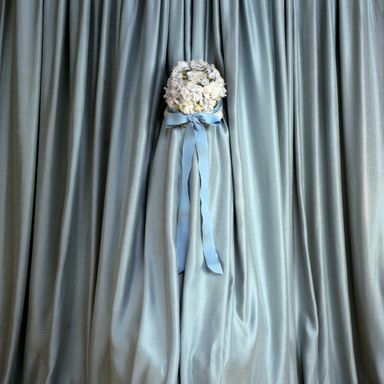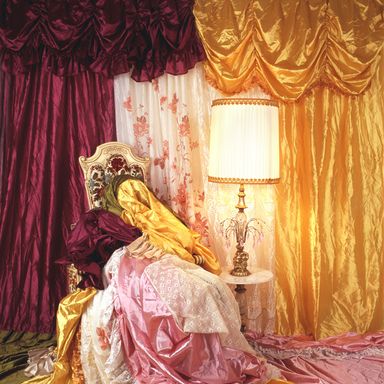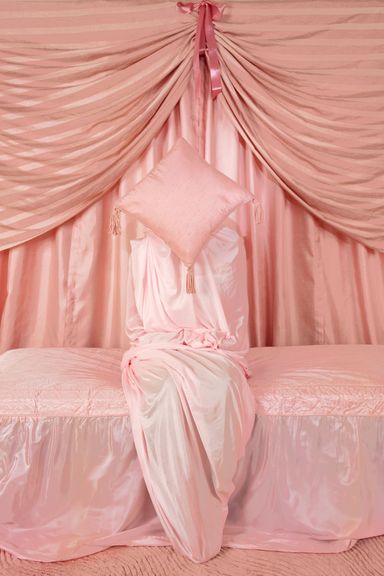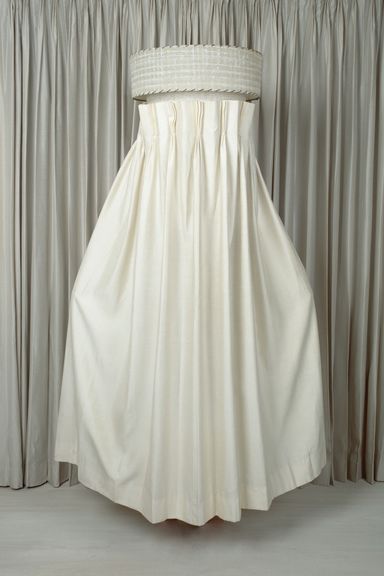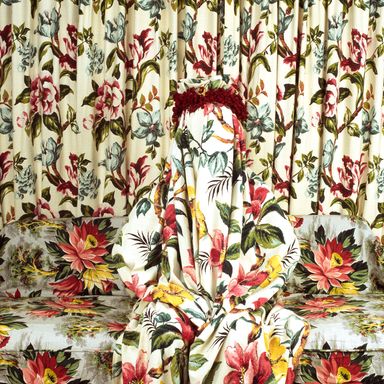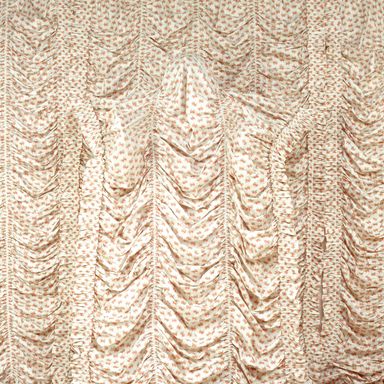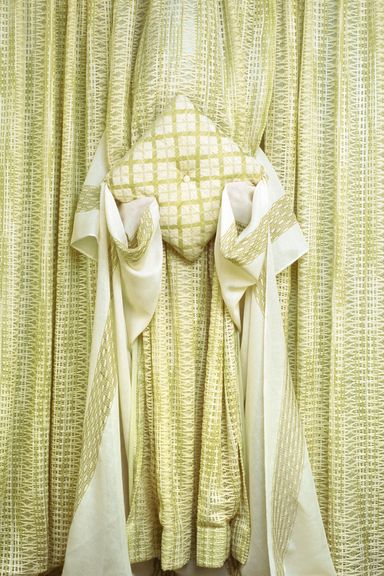Patty Carroll’s Draped, ‘Anonymous’ Women
Photographer Patty Carroll credits the process of “remaking a home again” (and a heady nostalgia for the fifties) as the impetus for her ongoing series, Anonymous Women. When she moved back to the States with her husband after a few years in England (where she taught photography at both the Royal College of Art and the London College of Printing), Carroll reacquainted herself and her new fifties ranch house — complete with “the original fifties kitchen in pink” — by decorating her new nest. “I started going to flea markets, antique stores, garage sales, and furnished the whole house,” she told the Cut.
Throughout her decorating spree, Carroll reached a new understanding of herself and the duality of her relationship with her home. “A home is a place of retreat and a place of power. [But while] women are safe in their homes, at the same time, there can become this obsession with decoration — and that can take over your identity.” In 2003, Carroll decided to dabble further with this idea with a touch of whimsy, and Anonymous Women was born.
Her photographs feature faceless women literally camouflaged into their own drapes. Whether the ladies appear trapped, engulfed, or content is up to anyone’s interpretation. The Cut spoke to the artist about her drape-scouting habits, how the woman behind the drapes represents all women, and how the nuns from her twelve years in Catholic school unintentionally influenced her work. She’s also recently started an accompanying video series of these same draped ladies attempting to do everyday tasks — like dancing or watering a houseplant — all while encumbered by the weight of those gaudy, garish drapes. Watch the clip below.
Why drapes? What tends to catch your eye?
A lot of [my usage of drapes] was actually influenced from being in England. When you’re in England, everyone has the most elaborate drapes on the windows. It was the first thing I noticed. When you come to States, maybe at the most, people have blinds or wooden blinds. Part of the drapery thing in England was that they were always used because the homes were not centrally heated for centuries. It’s something we don’t think about here, but it was one of the things that struck me. So when I got back to the States, I kind of got into this drape thing and also as this way of enclosing our lives and separating us from the rest of the world and making us covered. The drapes become like clothes or something.
You started this project in 2003, but it’s been ongoing. What kinds of drapes grab your attention?
One day I was passing a charity store for a hospital, and in the window they had this beautiful, crazy set of drapes that were these Roman shades. I went past it and was like, Oh my god, I have to start this series again. So I went in there and asked if I could rent them for a couple of days. I titled the finished piece “Ruffled.” From then on, my assistant and I just kept going. So now I just go to estate sales and garage sales and I just keep finding these stupid drapes. [Laughs.] It’s just bizarre. What’ll happen is I’ll go to an estate sale with nothing in mind, and then there’ll be, buried in some box, an entire box of old drapery, and then I’ll buy it for $10 and then you’ll have to use it.
Do you just have piles of them, I’m guessing?
Yes! Yes, yes. My garage is full of them.
Who are the women you photograph for this series?
It varies, but whoever stands in behind the drapes is a stand-in for all of us. She’s like the Wizard of Oz. The Wizard is behind [a curtain], pulling all these strings, and making things happen, and eventually, he’s revealed by the dog. But the point is that we’re all like that. It’s a place of power, where you’re making things happen in the home. But you’re not being. At the same time you’re like a slave to it — you’re cooking meals, making beds, cleaning things. Again, it’s an unseen job that you do. I’m trying to address both ends of that, both the sense of power and security. But it’s an endless job. You’re almost powerless in the end.
Some of the photos also seem to carry a vintage housewife feel. Was that a topic you wanted to explore?
Oh yeah. Well, [the idea for Anonymous Women] came from this furnishing of this fifties house. When I saw this house, I thought, Oh, this is the house I always wanted us to have when we were growing up. This was the idealized life that we never had. My youth was in the fifties and sixties, but it wasn’t like the magazines or TV serials. It was not anything like that. So to see this pristine house all perfect, it was like my second chance. Yes, there’s this idealization that we all have of the housewife and domestic life as being this perfect example of how things are supposed to be. And of course, it’s not. Nothing is ever like that, but it’s this kind of fantasy world that we project and that we make happen somehow. But of course, it’s not like that. It’s never like that.
The fabrics and styling are all so different. Did fashion play into this series as well?
Some of it is about camouflage, that you become part of the home. It becomes a whole issue of blending into the walls. Also, a lot of the pictures, to me, are like portraits of different kinds of women. The lady in stripes is a very different type of woman than the one with many different flowers. A lot of people also say to me, “It’s really about the burqa.” It is, because in the States particularly, we express ourselves through fashion. The women who wear these various kinds of burqas or the hijabs or any number of versions of covering yourselves, those women also underneath it, they wear the most wild, gaudy, glitzy clothing that you never see, which I think is so interesting, because it’s like there’s this secret person hiding behind that. Another influence is that I went to Catholic school for twelve years. At the time, all the nuns wore habits. I was used to seeing women clothed in a lot of fabric, where their identity was based on that nun’s habit.
Whose work tends to influence you?
Well, there’s a million influences, but nothing specific. I think it’s from my own internal craziness. [Laughs.]
